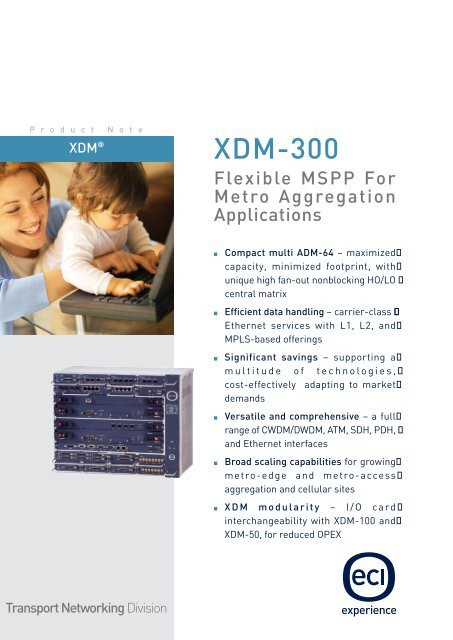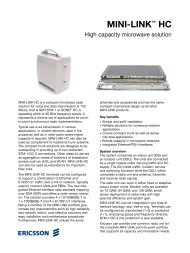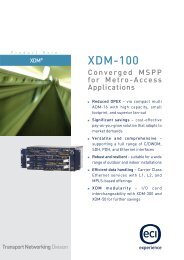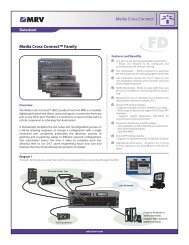XDM-300 - Kellner Telecom GmbH
XDM-300 - Kellner Telecom GmbH
XDM-300 - Kellner Telecom GmbH
You also want an ePaper? Increase the reach of your titles
YUMPU automatically turns print PDFs into web optimized ePapers that Google loves.
P r o d u c t N o t e<br />
<strong>XDM</strong> ®<br />
Transport Networking Division<br />
<strong>XDM</strong>-<strong>300</strong><br />
Flexible MSPP For<br />
Metro Aggregation<br />
Applications<br />
Compact multi ADM-64 – maximized<br />
capacity, minimized footprint, with<br />
unique high fan-out nonblocking HO/LO<br />
central matrix<br />
Efficient data handling – carrier-class<br />
Ethernet services with L1, L2, and<br />
MPLS-based offerings<br />
Significant savings – supporting a<br />
multitude of technologies,<br />
cost-effectively adapting to market<br />
demands<br />
Versatile and comprehensive – a full<br />
range of CWDM/DWDM, ATM, SDH, PDH,<br />
and Ethernet interfaces<br />
Broad scaling capabilities for growing<br />
metro-edge and metro-access<br />
aggregation and cellular sites<br />
<strong>XDM</strong> modularity – I/O card<br />
interchangeability with <strong>XDM</strong>-100 and<br />
<strong>XDM</strong>-50, for reduced OPEX<br />
experience
BREAKING THE BARRIER<br />
Introducing a unique architectural concept and design, the <strong>XDM</strong>-<strong>300</strong> is the most flexible<br />
and optimized platform for operator metro networks. The <strong>XDM</strong>-<strong>300</strong> breaks the barrier<br />
between metro-edge and metro-access functionality. It is a powerful platform for all<br />
metro and access applications, featuring:<br />
High-density metro aggregation for hub sites<br />
High capacity and compact MADM-16/64<br />
Metro traffic backhauling to core networks<br />
The <strong>XDM</strong>-<strong>300</strong> provides an extremely attractive combination of cost-effective yet high<br />
performance carrier-class Ethernet, SDH /SONET, PDH, and CWDM/DWDM services.<br />
This high adaptability and build-as-you-grow architecture leads to considerable<br />
savings in OPEX and CAPEX.<br />
AGGREGATION WITHOUT AGGRAVATION<br />
The great challenge that operators are currently facing is how to handle the growing<br />
demands for STM-1/OC-3 and STM-4/OC-12 interfaces delivered from access rings,<br />
customer premises equipment, and BTS/NB cells. This rise is being driven by the<br />
increasing demand by business customers for higher bandwidth to support voice, data,<br />
and video services. In response, operators are replacing traditional customer location<br />
equipment, mostly based on old PDH platforms, in order to manage miniature MSPPs.<br />
This trend is becoming more and more ubiquitous and the influence on access networks<br />
is significant.<br />
The superior <strong>XDM</strong>-<strong>300</strong> fan-out is the key for meeting the growing metro and access<br />
interface aggregation demands covering a wide range of services over a variety of<br />
technologies and infrastructures. This affords smooth and easy integration with existing,<br />
as well as future, network applications.<br />
SERVICES WITH A SMILE<br />
The <strong>XDM</strong>-<strong>300</strong> is based on a novel approach to MSPP for metro applications. It supports<br />
scalable STM-1/4/16/64/OTU2 (OC-3/12/48/192) aggregates and flexible access topologies.<br />
Designed and developed to provide a quick response to evolving networking requirements,<br />
this platform brings new levels of flexibility to metropolitan/access transport, cellular,<br />
and access ring-type architectures.<br />
The <strong>XDM</strong>-<strong>300</strong> provides a data service layer that terminates WAN links and aggregates<br />
Ethernet traffic arriving from the access network. Traffic can be carried to local Gigabit<br />
Ethernet interfaces or routed to the metro-core over SDH/SONET, enabling the following<br />
services and features:<br />
Carrier-class Ethernet as well as traditional SDH voice-centric services<br />
Gradual in-service capacity expansion based on service provisioning needs<br />
Nonblocking low-order/high-order cross-connect functionality<br />
Sublambda grooming resulting in high utilization of existing fibers and top efficiency<br />
in transmission of different types of services<br />
Common function redundancy and I/O interface protection<br />
Full compatibility with its <strong>XDM</strong>-100 and <strong>XDM</strong>-50 family counterparts (interchangeable<br />
I/O cards)
A TOUCH OF CLASS<br />
The <strong>XDM</strong>-<strong>300</strong> is the preferred carrier-class transmission solution for emerging Ethernet-based<br />
applications. Data applications have become the driving force in the telecommunications industry,<br />
providing a new approach to data service provisioning and connectivity. These include:<br />
Triple Play<br />
Business Connectivity (Enterprise and Medium/Small Offices)<br />
Mobile Aggregation<br />
DSLAM Transport and Aggregation<br />
The <strong>XDM</strong>-<strong>300</strong> is equipped with a broad range of Ethernet cards to support all services with<br />
end-to-end QoS. For example, the Layer 1, Layer 2, and MPLS cards are part of the overall<br />
<strong>XDM</strong> data-aware architecture. The system supports seamless Ethernet service delivery from<br />
metro-core all the way to customer premises.<br />
This platform is the optimal method to provide data-centric services, as follows:<br />
Ethernet Line (E-Line) for point-to-point connectivity, including:<br />
Ethernet Private Line (EPL)<br />
Ethernet Virtual Private Line (EVPL)<br />
Virtual Private Wire Service (VPWS)<br />
Ethernet LAN (E-LAN) for multipoint-to-multipoint (any-to-any) connectivity, designed for<br />
multipoint Ethernet VPNs and native Ethernet Transparent LAN Services (TLS), such as:<br />
Ethernet Private LAN (EPLAN)<br />
Ethernet Virtual Private LAN (EVPLAN)<br />
Virtual Private LAN Service (VPLS)<br />
E-Tree (Rooted-Multipoint) for point-to-multipoint<br />
Multicast Tree connectivity, designed for BTV/IPTV<br />
services, such as:<br />
Ethernet Private Tree (EP-Tree)<br />
Ethernet Virtual Private Tree (EVP-Tree)<br />
MPLS Routed-P2MP Multicast Tree (Drop & Continue)
BACKHAUL TO THE FUTURE<br />
Mobile operators are confronted with tough competition resulting from Average Revenue<br />
Per User (ARPU) erosion (largely due to reduction in voice services), technology shifts<br />
from legacy TDM-oriented 2/2.5G to 3G and 3.5G, as well as the introduction of wireline<br />
services (FMC/FMS). These factors are forcing operators to re-think their transport<br />
strategy in order to reduce OPEX while supporting the migration from TDM to<br />
packet-oriented networks. ECI's backhauling solution comprises two approaches, both<br />
managed under a unified management and OAM system. This allows mobile operators<br />
at different stages of infrastructure to select the most appropriate and efficient solution<br />
for their particular needs for the future.<br />
Low to Medium 3G Penetration<br />
In this scenario, 2G (or TDM-oriented) services expand in parallel with the introduction<br />
of 3G packet-based (ATM and/or IP) technology. Basing the solution on ECI's leading<br />
<strong>XDM</strong> MSPP product line, the operator gains:<br />
Native support of all legacy service expansion with highest QoS<br />
Integrated support of ATM with highest utilization of backhaul resources<br />
Variety of Ethernet services over MPLS for introducing IP UTRAN and/or data<br />
applications for business services<br />
Integrated NG optics (ROADM) supporting both capacity expansion AND topology<br />
changes in the most flexible and efficient way<br />
The main benefit of this method is that it supports any stage of evolution with the most<br />
appropriate technology (and media), while allowing smooth migration towards full<br />
packet-based networks when needed.<br />
The <strong>XDM</strong>-<strong>300</strong> was designed as an optimized platform to be located at HUB sites in the<br />
RAN in terms of size, functionality, and price, featuring:<br />
Scalable and flexible solutions for increasing traffic demands<br />
Higher bitrate multiple ring and link closure toward hub sites (STM-1/4/16/64 or<br />
OC-3/12/48/192 rings)<br />
Aggregate traffic from BTSs and Node B's from E1s to GbE<br />
Efficient handling of advanced data services (WLAN, IP migration) and additional<br />
data services provided by cellular operators<br />
Fast provisioning with superior QoS<br />
Higher network resiliency at any layer or interface
Medium to High 3G Penetration (developed markets)<br />
Operators who face massive increases in packet-based traffic (high penetration of<br />
HSPA-based services or introduction of mobile WiMAX in the future) require a more<br />
packet-oriented infrastructure. In most scenarios, the introduction of a new packet layer<br />
is implemented gradually, in parallel with the existing MSPP network. In this case, the<br />
interoperability and ability to create end-to-end services, as well as OAM for the services<br />
on both networks, is crucial. ECI's solution provides a unified network approach and<br />
smooth evolution from legacy to packet-based.<br />
COLOR YOUR WORLD<br />
The <strong>XDM</strong>-<strong>300</strong>'s CWDM capability makes it a natural choice for metro-edge and<br />
metro-access environments. As a powerful converged multiservice platform optimized<br />
for metro networks, <strong>XDM</strong>-<strong>300</strong> integrates high-capacity and cost-conscious CWDM with<br />
SDH sublambda grooming and efficient data transport, enabling smooth migration from<br />
today's SDH transmission technologies to CWDM terabit capacities.<br />
The compact <strong>XDM</strong>-<strong>300</strong> shelf houses a variety of CWDM, OADM, transponder, OFA,<br />
combiner, and other optical cards and modules used to process, amplify, and monitor<br />
multichannel signals. It provides up to 16 integral slots for transponder and combiner<br />
modules for a variety of services, including:<br />
Lambda-based services from 100 Mbps up to 2.5 Gbps<br />
Data, digital video, Ethernet, and other digital services<br />
High-order transmission paths for IP networks<br />
THE 5 TH DIMENSION<br />
The remarkable LightSoft ® multidimensional network management system for converged<br />
networks handles two physical layers and several technology layers, including SDH/SONET,<br />
optical, and Ethernet (data). Its advanced GUI includes flexible fault management tools,<br />
end-to-end trail definition, database backup, and sophisticated Customer Network<br />
Management (CNM) that enables monitoring and allocating available network resources<br />
to a wide variety of clients for maximum profitability. Within one integrated management<br />
system, LightSoft allows users to fully control and obtain a complete overview of all<br />
network elements.
TECHNICAL SPECIFICATIONS<br />
Interfaces, Topologies, and Protection<br />
SDH tributary and aggregate interfaces STM-1, STM-4, STM-16, STM-64<br />
SONET tributary and aggregate interfaces OC-3, OC-12, OC-48, OC-192<br />
PDH tributary interfaces E1, E3, DS-3<br />
Data-aware interfaces 10/100/1000 Mbps, Ethernet, IP, ATM<br />
Topologies Mesh, multi-ring, ring, star, linear<br />
System Capacities<br />
Pluggable SFP/XFP support Electrical, non-colored, C/DWDM<br />
Ethernet Layer 1: Layer 2 1 : MPLS:<br />
128 x 10/100BaseT 96 x 10/100BaseT 64 x 10/100BaseT<br />
64 x 10/100 FX 96 x 10/100 FX 64 x 10/100 FX<br />
64 x 1000BaseT 32 x 1000 BaseT 64 x 1000 BaseT<br />
64 x 1000 SX/LX 32 x 1000 SX/LX 64 x 1000 SX/LX<br />
SDH/SONET 128 x STM-1/OC-3<br />
64 x STM-4/OC-12<br />
24 x STM-16/OC-48<br />
6 x STM-64/OC-192<br />
PDH 504 x E1, 48 x E3, 48 x DS-3<br />
CWDM Specifications<br />
Number of channels 1, 2, 4, 8, 16<br />
Max. distance Over 100 km<br />
Channel spacing (nm) 20<br />
Continuous 2R/2R transponder STM-1/4/16, OC-3/12/48, digital video, Ethernet,<br />
Fiber Channel, ESCON, FICON, etc.<br />
CWDM combiner<br />
Other Specifications<br />
2 x GbE/FC/FICON to 2.7 Gbps OTN<br />
Power input -40 VDC to -75 VDC<br />
Max. power dissipation 1600 W, 5465 BTU/h<br />
Operating temperature range -5°C to +55°C<br />
-23°F to +131°F<br />
Operating RH range 5% to 95%<br />
Environmental standards ETS <strong>300</strong> 019-1-3 Class 3.2<br />
ETS <strong>300</strong> 019-1-1 Class 1.2<br />
ETS <strong>300</strong> 019-1-2 Class 2.3<br />
Safety EN 60950-1:2006, according to LVD Directive 72/23/EEC<br />
EN 60825-1&2<br />
NEBS GR-63-CORE (level 3), GR-1089-CORE, UL 60950:1,<br />
last edition<br />
EMC EN <strong>300</strong> 386-2, 1TR9<br />
Management End-to-end management of all layers and services<br />
Physical dimensions 325 mm (H) x 443 mm (W) x <strong>300</strong> mm (D)<br />
12.8 in (H) x 17.4 in (W) x 11.8 in (D)<br />
1 Reaching maximum ports per shelf requires the use of DIOM cards as port extenders<br />
ECI Headquarters<br />
Tel: +972-3926-6555<br />
Fax: +972-3928-7100<br />
EMEA<br />
Tel: +44-1256-388000<br />
Fax: +44-1256-388144<br />
Asia Pacific<br />
Tel: +65-6297-7335<br />
Fax: +65-6299-2716<br />
Russia<br />
Tel: +972-3926-8548<br />
Fax: +972-3926-6452<br />
America<br />
Tel: +1-954-772-3070<br />
Fax: +1-954-351-4404<br />
Copyright © 2007 ECI <strong>Telecom</strong>. All rights reserved. Information in this document is subject to change without notice. ECI <strong>Telecom</strong> assumes no responsibility for any errors that may appear in this document.<br />
<strong>XDM</strong>_pn_<strong>XDM</strong>-<strong>300</strong>_01_en_01-03-07













